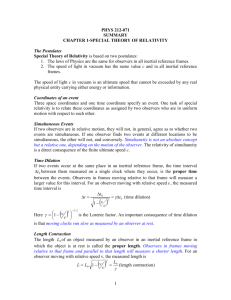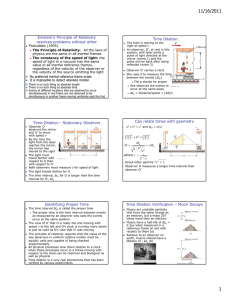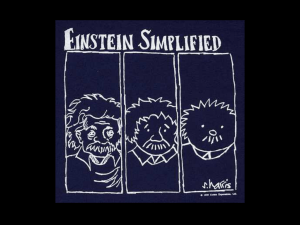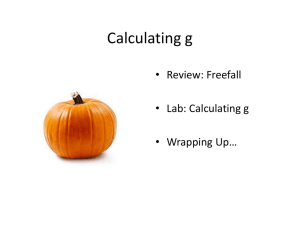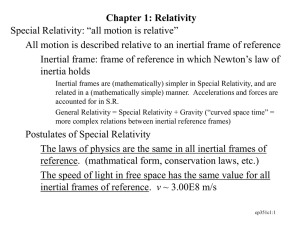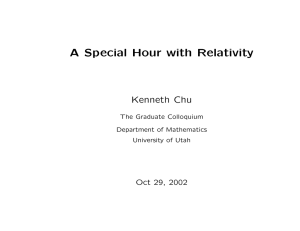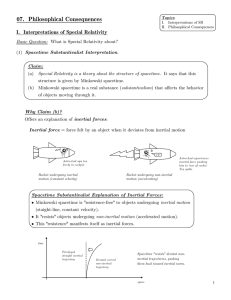Special Relativity
advertisement
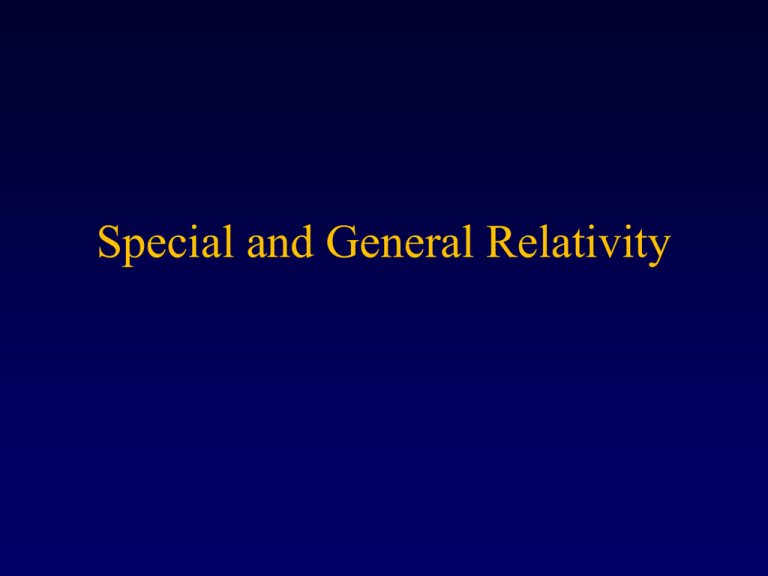
Special and General Relativity Inertial reference frame: a reference frame in which an acceleration is the result of a force. Examples of Inertial Reference Frames 1. This room . Experiment: Drop a ball. It accelerates downward at 9.8 m/s2 due to the force of gravity. 2. The inside of a car moving at constant speed along a straight road. Repeat the experiment. Results are the same as in #1. 3. The inside of an elevator that is moving either upward or downward at constant speed. Results are the same as in #1 and #2. Examples of Non-inertial Reference Frames 1. 2. The interior of a car that is either speeding up, slowing down, or going around a curve. Experiment: Drop a ball. If the car is slowing down. The ball accelerates downward and towards the front of the car. The acceleration toward the front of the car is not due to a force on the ball. The inside of an elevator that is accelerating either upward or downward. If the elevator is accelerating upward, the ball accelerates downward faster than 9.8 m/s2. The additional downward acceleration is not due to a force on the ball. Fundamental Assumptions of the Special Theory of Relativity 1. 2. The laws of physics have the same form in any inertial reference frame; in other words, no experiment can be done in an inertial reference frame to detect its state of motion. The speed of light in vacuum has the same value when measured by any observer, regardless of the observer’s state of motion. Time Dilation as a Consequence of the Postulates • • Both O and O' (pronounced “O prime”) are in inertial reference frames. O stands by the railroad track and watches O' move by at constant velocity. Construct a simple clock in the railroad car, consisting of a mirror on the floor and another directly above it on the ceiling. Let a pulse of light bounce back and forth between floor and ceiling. Each round trip is a tick of the clock. Reference Frame of Observer O' Moving at Constant Velocity Direction of the Railroad Car’s Constant Velocity Reference Frame of a Stationary Observer O Time per Tick as Measured by O’ O' sees the light having only vertical motion. L t t up t down tup tdown t L L c c c = the speed of light = 3.00×108 m/s t 2L c Time per Tick as Measured by O O sees the light moving horizontally as well as vertically. Use the Pythagorean theorem to calculate tup and tdown c2 t 2up L2 v 2 t 2up L2 t 2 c v2 t down t up 2 up t up L c ctup 1 1 v ctdown L 2 c2 vtup vt t t up t down 2L t c 1 1 v2 c 2 t t 1 v2 c2 This is the time dilation formula of special relativity. •The time per tick measured by the moving observer O' is shorter than the time per tick measured by the stationary observer O. •Any clock at rest relative to O' is slower than any clock at rest relative to O. •Time elapses more slowly for a moving observer. Length Contraction Similar logic shows that when O measures the distance between two points on the train along the direction of motion, he gets a smaller result than O' does. This is called length contraction and its quantitative expression is the following equation. v2 L = L¢ 1 - 2 c Ĺ́ ́́ is the distance between two events as measured by someone at rest relative to the events, and L is the distance measured by someone moving relative to them. Examples 1. 2. Suppose that O and O' have identical meter sticks and that the speed of O' relative to O is 0.8 times the speed of light. When O measures the length of O'’s meter stick, he finds that it is only 0.6 m long. Likewise, when O' measures Os meter stick, he finds that O’s meter stick is only 0.6 m long. A and B are 30 year old twins. A stays on Earth while B travels in a spaceship at 0.99875 times the speed of light to a star 10 light years away and immediately returns after making some observations that take only a few hours. How old are the twins when B arrives back at Earth? How far did B travel? A watches B make a round trip of L = 2 ×10 = 20 light years while moving at about 1 light year per year. For him, 20 years elapse (t = 20 years) and he is (30 + 20) = 50 years old. On the other hand, B experiences time dilation. For her, the elapsed time is t' = 20 × 0.05 = 1 year. She is only 31 years old when she returns. While A watches B make a 20 light year round trip, B finds herself traveling only L' = 20× 0.05 = 1 light year. 3. Atomic Clock Experiment by C.O. Alley in 1975 t 15 hours v 104 m / s 313 mph t 5.6 107 s measured. t 5.7 107 s predicted by special relativity. 4. Muon decay lifetime in laboratory = 2 106 s measured lifetime of cosmic ray-generated muons = 30 106 s 5. Dependence of Mass on Speed m m0 v 1 c 2 6. Mass-energy Equivalence E m0 c 2 Spacetime and General Relativity • • • • • • • The examples on the previous slide illustrate the fact that the time between two events and the distances between them are not absolute. They depend on the motion of the person who measures them. However, this doesn’t mean that everything is relative. It is important to know what is absolute (independent of the observer). Physicists recognize that a combination of space and time called spacetime is the same for all observers. For both Aand B, the spacetime interval between B́́s departure and return is zero. The space-time of special relativity is one in which the shortest spacetime path between two points is a straight line. In a vacuum, for example, the path of a ray of light is a straight line The presence of mass bends space-time. The result is what we call gravity. A satellite in orbit, for example, follows the curvature of spacetime. Physics that takes this into account is called general relativity. According to general relativity, gravity causes a time dilation similar to that caused by motion. Gravity affects time by slowing it down; i.e., time elapses more slowly where gravity is strong. Gravity affects spacetime by bending it, stretching it, and compressing it. Local Inertial Reference Frames A local inertial reference frame is one that is falling freely and is small enough for tidal effects to be negligible. L2 L3 A planet or some other massive object a=g L1 is far from any massive object and is accelerating. It is not a local inertial reference frame L1 a = -g Experiments in L2 will show the effects of gravity. It is not a local inertial reference frame. L3 is falling freely. It is a local inertial reference frame if it is small enough that no experiment in L3 can show the effects of gravity. The Equivalence Principle • • • If L is at rest in a region where there is a uniform gravitational field g and L' is far from any massive bodies but is undergoing an acceleration, – g, identical experiments in the two laboratories will give identical results. A locally uniform gravitational field is equivalent to a uniform acceleration No experiment conducted inside a sufficiently small laboratory can distinguish between a uniform gravitational field and a uniform acceleration of that laboratory. L' a = -g A B L A B Laser beam from A to B in L'. AB curved due to acceleration. g Laser beam from A to B in L. Same result as in L'. The effect of gravity is to bend spacetime. In a freely falling laboratory, AB would be a straight line. The Bending of the Path of a Light Ray as it Passes a Massive Object (Star, Neutron Star, Black Hole) S C E The diagram shows Earth (E), a massive object (C), and a distant star (S). C could be a star, neutron star, or black hole. The solid green line shows the path of a light ray from S. Instead of being a straight line as it would if C were not present, it is curved because C bends the space-time in its neighborhood. From Earth, the star appears to be located in the direction indicated by the dotted line. Animations showing what we would see if we approached a neutron star or black hole can be found at http://antwrp.gsfc.nasa.gov/htmltest/rjn_bht.html. Double Einstein Rings A foreground galaxy ( about 3 billion light years away) bends space around it to form a “gravitational lens”. As light from two more remote galaxies travels toward us, it follows the curvature of this space to form the “Einstein rings” shown here. Deflection of starlight passing near the sun: Prediction of general relativity: 1.75". Best measurement: 1.66" ± 0.18" Gravitational Time Dilation Time elapses more slowly in regions where gravity is strong than in regions where it is weak. Specifically, time elapses more slowly near a compact stellar object than it does far from it. This is expressed quantitatively by the equation at the right. t t R 1 s r t is the time interval between two events that take place at distance r from the center of the compact object as measured by an observer very far from the compact object. t' is the time interval between the same events as measured by an observer O' at distance r from the center of the compact object. Rs = the Schwartzschild radius = (3 km) × M M = the mass of the compact object in solar masses. An indestructible astronaut O' falling into a black hole would find himself very quickly crossing the event horizon (time t'). As we watched him, according to the time dilation formula, we would never see him arrive at the event horizon because as r approaches Rs, t approaches infinity. Perihelion Precession Measured Perihelion Precession Planet Observed Excess Precession Relativistic Prediction Mercury 43.11±0.45 43.03 Venus 8.4 ± 0.48 8.6 Earth 5.0 ± 1.2 3.8 Icarus 9.8 ± 0.8 10.3
